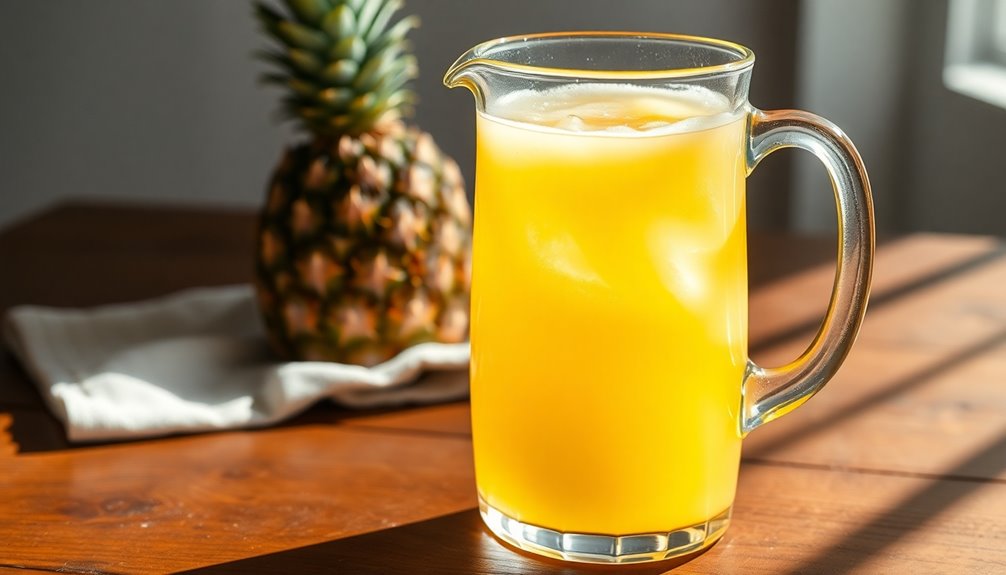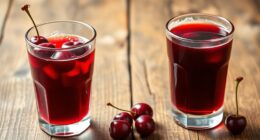Fresh pineapple juice lasts about 3 to 5 days in the fridge if you store it properly in an airtight container. For the best taste and nutrition, it's best to drink it within 24 hours. Keep it at a consistent temperature between 36°F and 46°F to maintain its freshness. Watch out for spoilage signs like sour smells, bubbles, or dark color. If you're curious about creative uses and health benefits, there's plenty more to explore!
Key Takeaways
- Fresh pineapple juice lasts 3 to 5 days when stored properly in the refrigerator.
- Optimal storage requires an airtight container to maintain freshness.
- For best taste and nutrients, consume fresh juice within 24 hours.
- Keep the refrigerator temperature consistently at or below 40°F (4°C).
- Signs of spoilage include sour smells, bubbles, cloudiness, or darkening color.
Shelf Life of Fresh Pineapple Juice

When you store fresh pineapple juice properly, it typically lasts between 3 to 5 days in the refrigerator.
To maximize its shelf life, make certain you use an airtight container and keep it at an ideal temperature between 36°F and 46°F (2°C to 8°C).
While refrigerated pineapple juice can be kept for up to 7 days, consuming it within the first few days guarantees you get the most nutrients. Additionally, fresh pineapple juice is high in vitamin C, which is essential for immune system support.
Always check for signs of spoilage, such as sour or fermented smells, bubbles, cloudiness, or darkening color.
If you notice any of these, it's best to discard the juice.
Factors Affecting Freshness

When it comes to keeping your fresh pineapple juice at its best, several factors play a key role.
You need to pay attention to the storage temperature, the type of container you use, and how long the juice stays fresh.
Each of these elements can greatly impact the quality and flavor of your juice.
Storage Temperature Importance
While you might be tempted to store fresh pineapple juice at room temperature, maintaining the right storage temperature is essential for preserving its freshness. Ideally, you should keep it at or below 40°F (4°C) to minimize bacterial growth and prolong freshness. Consistent refrigeration is key; temperatures between 36°F and 46°F (2°C to 8°C) are perfect for keeping it fresh for 3 to 5 days. If you store it above this range, spoilage can occur more quickly due to natural acids and enzymes. Additionally, improved air quality can help maintain the freshness of stored foods, including juices, by reducing the risk of spoilage from airborne contaminants.
| Storage Temperature | Freshness Duration |
|---|---|
| 36°F to 46°F | 3 to 5 days |
| Above 40°F | Spoils quickly |
| Frozen | Up to 4 months |
Make sure you store it properly!
Container Type Matters
Choosing the right container for storing fresh pineapple juice can make a significant difference in its freshness and flavor.
Container type matters, and using airtight glass bottles is your best bet to prevent oxidation and spoilage. Unlike plastic containers, glass maintains flavor integrity and doesn't absorb odors or flavors that could compromise your juice.
If you opt for opaque containers, they can help block light exposure, further preserving nutrients and extending freshness.
Always make sure your container is clean and sanitized before pouring in the juice; contaminants can accelerate spoilage. Additionally, using energy monitoring features can help you keep track of how much energy your refrigerator uses to maintain optimal juice storage conditions.
Juice Freshness Duration
Storing fresh pineapple juice in the right container can considerably influence its freshness duration. Typically, fresh pineapple juice lasts 3 to 5 days in the fridge when you use an airtight container.
If you pasteurize it properly and refrigerate it right away, pineapple juice can last 5 to 7 days. To keep your juice fresh for longer, maintain a consistent temperature of 40°F (4°C) or lower.
Also, avoid exposing your juice to light and guarantee your container is clean. Remember, signs of spoilage—like a sour smell, cloudiness, or mold—mean it's time to discard the juice.
Unlike store-bought pineapple juice, fresh juice requires more attention to keep it safe and enjoyable.
Signs of Spoilage
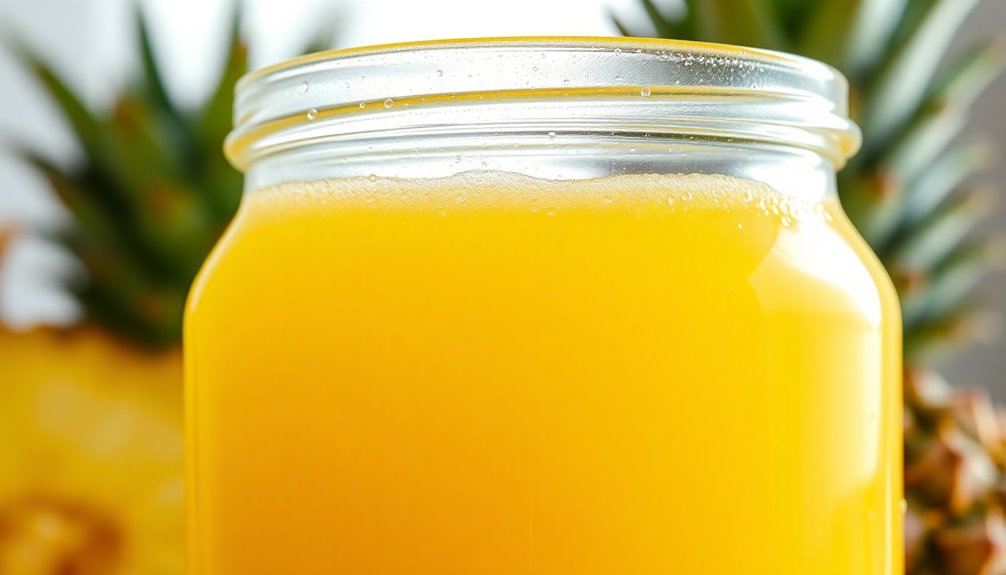
When you're checking your fresh pineapple juice, pay attention to the container's condition and any changes in odor.
If you notice a sour smell or see bubbles and cloudiness, it's time to reconsider that juice.
Darkening color and mold growth are definite signs that you should toss it for your safety.
Container Condition
While fresh pineapple juice can be a delicious treat, it's important to keep an eye on its container condition to spot any signs of spoilage.
To guarantee your juice lasts as long as possible, check for the following:
- Sour Smell: If your pineapple juice smells sour, it's starting to ferment.
- Bubbles or Cloudiness: Look for bubbles or cloudiness, indicating fermentation has occurred.
- Darkening Color: Fresh pineapple juice should maintain a bright yellow hue; darkening could signal spoilage.
- Mold or Swelling: Any mold growth or a swollen container means you should discard the juice immediately.
To keep your pineapple juice fresh, always store it in an airtight container.
Odor Changes
As you enjoy fresh pineapple juice, it's crucial to be aware of any odor changes that might indicate spoilage. If you notice a sour or fermented smell, it's a strong sign that your juice has gone bad.
Fresh pineapple juice typically lasts 3 to 5 days in the fridge, so any off-putting odors mean it's time to discard it. The smell is often the first indication of spoilage, so trust your nose.
Visual Indicators
To guarantee your fresh pineapple juice is safe to drink, keep an eye out for visual indicators of spoilage.
These signs can help you determine if your juice has gone bad, ensuring you can still enjoy its health benefits.
Look for:
- Bubbles or cloudiness – This suggests fermentation, making the juice unsafe to consume.
- Darkening color – Fresh pineapple juice should remain bright yellow or golden; any significant darkening is a warning.
- Mold growth – If you see mold on the surface or around the container, discard it immediately.
- Swollen or damaged container – This indicates potential spoilage, so it's best to throw the juice away.
Proper Storage Techniques
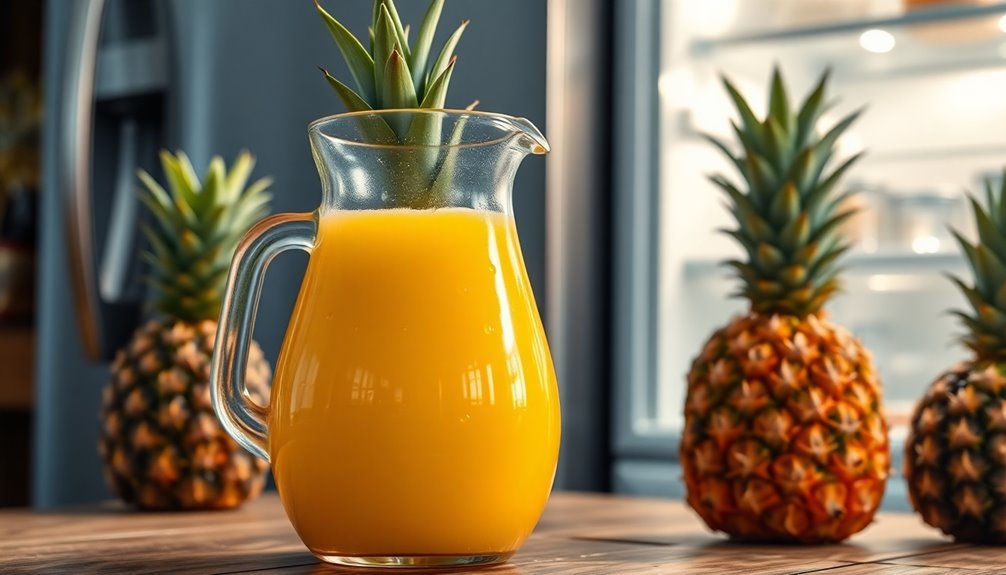
Storing freshly made pineapple juice properly is essential for keeping its flavor and nutrients intact.
To guarantee your juice lasts, always use an airtight container and keep it in the refrigerator. The ideal temperature range is between 36°F and 46°F (2°C to 8°C).
Fresh juice typically stays good for 3 to 5 days, but it's best consumed within 24 hours for maximum nutrients and taste.
Before drinking, always check for any signs that the juice may have gone bad, such as a sour smell, cloudiness, or mold.
Freezing Pineapple Juice
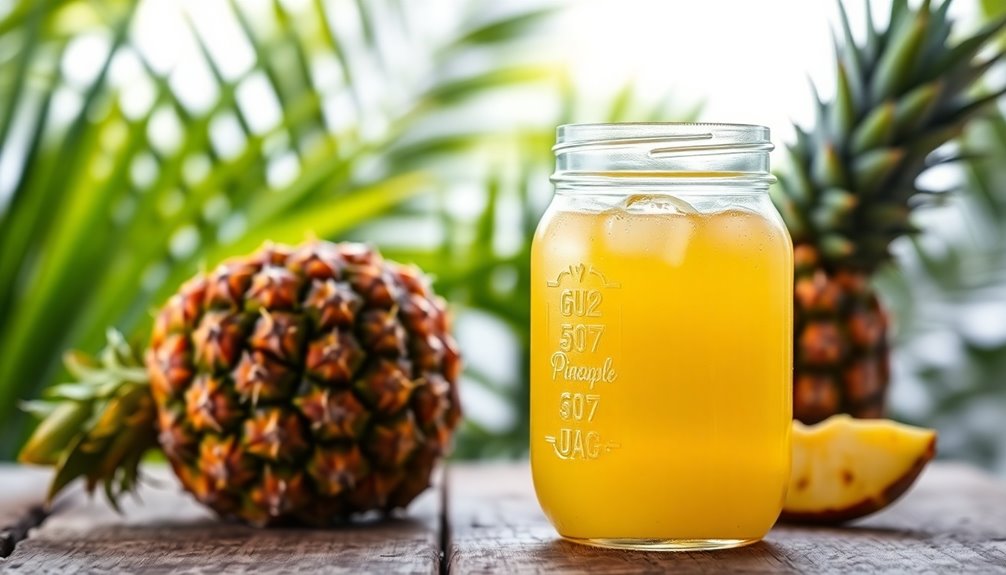
If you want to enjoy the revitalizing taste of pineapple juice long after it's made, freezing is a great option. Here's how to do it right:
- Store your frozen pineapple juice in airtight containers or silicone ice cube trays to prevent freezer burn.
- Leave some space in the containers for expansion during freezing to avoid breakage.
- Label each container with the date, ensuring you can track its shelf life and use it within the ideal time frame.
- For thawing pineapple juice, use the refrigerator for the best flavor and quality; if thawed quickly in a microwave or cold water, consume it immediately.
With these tips, you can savor your frozen pineapple juice for up to 4 months!
Creative Uses for Leftover Pineapple Juice
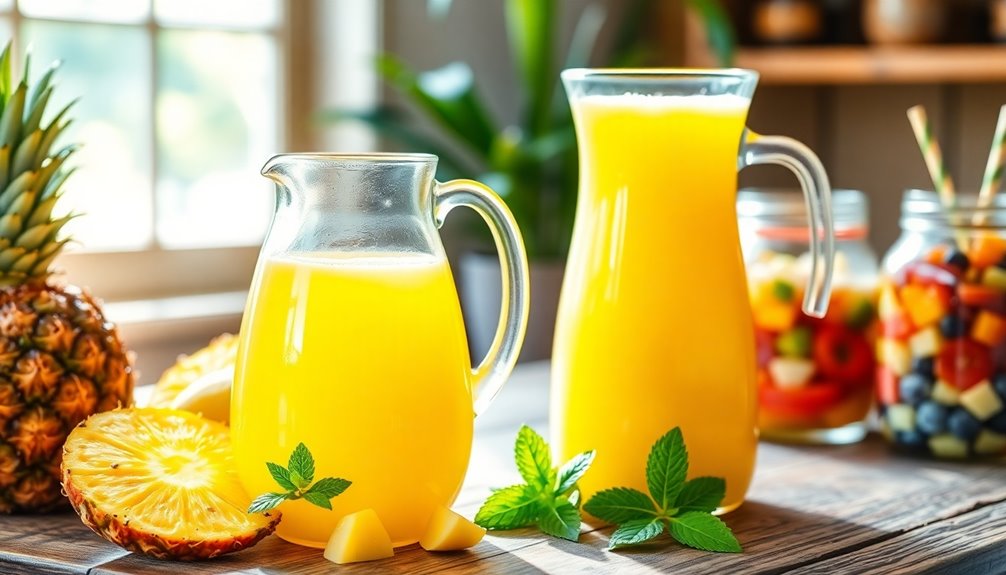
After enjoying your frozen pineapple juice, you might find yourself with some leftover juice that deserves to be used creatively. The good news is that there are plenty of ways to make delicious dishes and drinks with just a small amount of juice. Keep an eye on these ideas to help you enjoy that leftover juice:
| Use | Description |
|---|---|
| Smoothies | Use it as a natural sweetener for tropical flavors. |
| Salad Dressings | Mix with olive oil, vinegar, and herbs for zest. |
| Marinades | Tenderize meats like chicken with its enzymes. |
| Tropical Glaze | Reduce juice for a thick, dessert drizzle. |
These ideas will elevate your meals and refresh your beverages! Additionally, you can use leftover juice in creative culinary applications to enhance the flavors of various dishes.
Nutritional Benefits of Pineapple Juice
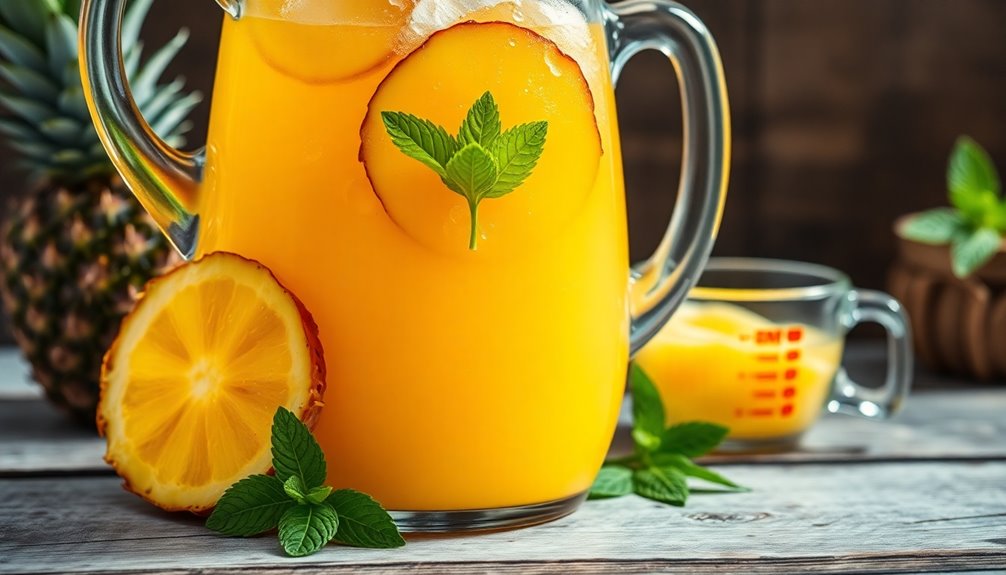
While you might enjoy the revitalizing taste of pineapple juice, it's also packed with impressive nutritional benefits.
Here are four reasons to sip on this delicious drink:
- Rich in Vitamin C: A 250ml serving provides 100% of your daily value, boosting your immune system and acting as a powerful antioxidant.
- Packed with Antioxidants: These help eliminate harmful free radicals, reducing oxidative stress and potentially lowering cancer risk.
- Contains Bromelain: This enzyme has anti-inflammatory properties, aiding digestion and may help with digestive upset.
- High in Manganese: Offering 55% of your daily needs, it supports metabolism and bone health.
With all these benefits, pineapple juice is a tasty way to enhance your health!
Frequently Asked Questions
How Long Does Fresh Pineapple Juice Stay Good in the Fridge?
Fresh pineapple juice typically stays good in the fridge for about 3 to 5 days when you store it in a sealed container.
If you've made homemade juice, try to drink it within 24 hours for the best nutrients.
Once you open a store-bought bottle, it's best to finish it within 5 to 7 days.
Always check for sour smells, cloudiness, or bubbles, as these are signs it's gone bad.
How Long Can You Keep Fresh Juice From a Juicer?
When you've just juiced fresh fruits, you want to savor every drop, enjoy every nutrient, and maximize every moment.
Fresh juice from a juicer typically lasts 3 to 5 days in the fridge if stored properly in an airtight container. For the best taste and health benefits, drink it within 24 hours. To maximize freshness, always use high-quality fruits and vegetables, as the nutrient content and flavor can degrade quickly after juicing. If you’re wondering, “how long does vegetable juice last? ” it generally follows the same timeline as fruit juice, lasting about 3 to 5 days in the refrigerator. However, like fruit juices, consuming vegetable juice sooner rather than later ensures you get the most vibrant flavor and nutritional benefits.
If you're looking to keep it longer, freeze it in portions, and you could enjoy it for up to 4 months.
How Long Does Del Monte Pineapple Juice Last After Opening?
Once you've opened Del Monte pineapple juice, you can enjoy it for about 5 to 7 days if you store it properly.
Make sure it's in an airtight container and kept in the fridge at or below 40°F (4°C).
Always check the expiration date before opening, and look out for signs of spoilage like a sour smell or bubbles.
Keeping the container tightly sealed helps maintain its freshness for longer.
Can Pineapple Juice Be Bad?
Yes, pineapple juice can go bad.
You'll know it's spoiled if you notice a sour smell, bubbles, or cloudiness, which indicate fermentation. Mold growth on the surface is another red flag.
If the juice has darkened in color or the container looks swollen, it's best to toss it.
Always store your juice properly in an airtight container in the fridge to keep it fresh for as long as possible.
Conclusion
In the dance of flavors, fresh pineapple juice brings sunshine to your fridge, but it won't last forever. Embrace its vibrant spirit within five to seven days, or freeze it for a taste of summer on a chilly day. Keep an eye out for signs of spoilage, and store it right to savor every drop. So, whether you sip it straight or whip it into a creative treat, let the tropical sweetness brighten your day!
Cindy thoroughly researches juicing trends, techniques, and recipes to provide readers with practical advice and inspiration. Her writing style is accessible, engaging, and designed to make complex concepts easy to understand. Cindy’s dedication to promoting the advantages of juicing shines through her work, empowering readers to make positive changes in their lives through the simple act of juicing.

